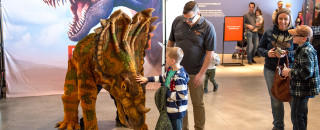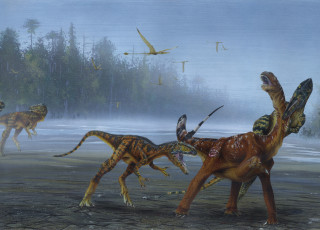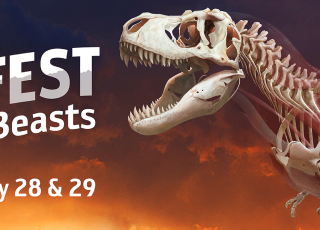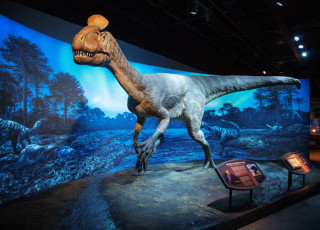STOMP, CHOMP AND ROAR INTO THE AGE OF DINOSAURS AT THE NATURAL HISTORY MUSEUM OF UTAH’S 4TH ANNUAL DINOFEST, JAN. 25-26
SALT LAKE CITY, Jan. 16, 2020 – It’s DinoFest season at the Natural History Museum of Utah and the community is invited to explore all things dinosaur for two action-packed days on Saturday, Jan. 25 and Sunday, Jan. 26, from 10 a.m. to 5 p.m. each day at the Rio Tinto Center, 301 Wakara Way, Salt Lake City.
“This year’s DinoFest will help celebrate the Museum’s 50th anniversary in Utah, with a special emphasis on our state’s allosaurus, along with a spectacular line up of research scientists, dinosaur experts and community enthusiasts, who will share interesting information, discoveries and evidence surrounding the topic of extinction,” explains Paulmichael Maxfield, adult and gallery program manager at the Museum.
Festivalgoers will have rare access to the Paleo Fossil Prep Lab and Paleo Collections areas, as well as the Museum’s 50th anniversary special exhibit, Nature All Around Us. Gallery educators will roam the Past World’s Gallery to answer questions and give visitors the opportunity to see and touch real dinosaur bones and casts. Special activities for kids will also be featured, including a chance to hop into Dino-themed photo ops, spring into Dino yoga or enjoy a host of hands-on Dino-themed activities designed for the whole family.
“As someone who has really enjoyed attending DinoFest in year’s past, I’m even more excited to have the opportunity to participate as a community partner this year,” states Lorraine Chure, artist and jewelry maker whose geology and paleo-inspired designs will be available during DinoFest.
Other community partners also involved include Bower Bird Art Studio, Golden Spike Gem and Mineral Society, Utah Field House of Natural History State Park Museum, Utah Friends of Paleontology and more.
Serious science buffs can catch up on the latest research surrounding extinction from several noted experts, including Dr. J. Tyler Faith, Curator of Archaeology at the Museum, who will present insights from some of his most recent work.
Says Faith, “the extinction of the dinosaurs leaves no question that life on Earth is precarious, largely due to human impacts. The archaeological record makes it very clear that our impacts extend deep in time, but just how deep in time is a matter of debate. I look forward to sharing my research with the DinoFest audience.”
Additional researchers speaking during this year’s event are as follows:
- Keynote speaker Julia A. Clarke, Wilson Professor in Vertebrate Paleontology at the University of Texas at Austin and Howard Hughes Medical Institute Professor will address, “Survivorship at the Cretaceous-Paleogene boundary,” Saturday, January 25 - 12 p.m.
- Ian Miller, Curator of Paleobotany & Director of Earth & Space Sciences at the Denver Museum of Nature & Science will address, “Correlated plant diversity and climate in North America across the Paleogene mass extinction,” Saturday, January 25 - 1:30 p.m.
- Cornelia Rasmussen, postdoctoral fellow, University of Texas at Austin will address, “The need for catastrophe – did the asteroid that killed the dinosaurs create a new habitat?”
- Antoine D. Bercovici, is a palynologist (studies pollen & spores) and a postdoctoral scientist, University of Nottingham, research associate, National Museum of Natural History, (Smithsonian), and Denver Museum of Nature & Science will address, “The collapse of a green world,” Saturday, January 25 – 2:30 p.m.
- Tyler Faith, Curator of Archaeology, Natural History Museum of Utah, Assistant Professor of Anthropology, University of Utah will address, “The extinction of Africa’s megaherbivores: ancient homin impacts or climate change?” Saturday, January, 25 – 3:00 p.m.
- Keynote speaker Tyler Lyson, Curator of Vertebrate Paleontology, Denver Museum of Nature & Science will address, “Earth’s Last Dinosaur Ecosystems,” Sunday, January 26 at 12 p.m.
- Paige Wilson, PhD candidate studying paleobotony, University of Washington will address, “Ferns, sycamores, and palm trees: which plants survived the Cretaceous-Paleogene mass extinction?” Sunday, January 26 – 1:30 p.m.
- Thomas Williamson, Curator of Paleontology, New Mexico Museum of Natural History & Science will address, “The Cretaceous-Paleogene transition of the San Juan Basin, New Mexico,” Sunday, January 26 – 2:00p.m.
- Keegan Melstrom, postdoctoral researcher, Dinosaur Institute, Natural History Museum of Los Angeles will address, “For a while, crocodile: crocodilian endurance through mass extinctions,” Sunday, January 26 – 2:30 p.m.
For additional information, discount tickets or to sneak a peek of what DinoFest is all about, visit: nhmu.utah.edu/events/dinofest-2020.
# # #
About the Natural History Museum of Utah
The Natural History Museum of Utah is one of the leading scientific research and cultural institutions in the country. Open to the public in 1969, and into its spectacular award-winning new home in 2011, the Museum’s collections contain over 1.6 million objects and offers innovative exhibitions and educational programs to thousands of residents and visitors each year, including traveling and permanent exhibits, special events and other programs. With an expected attendance of 300,000 visitors a year, the Museum also offers a variety of outreach programs to communities and schools throughout Utah, reaching every school district in the state annually. The Museum has an active science program with more than 30 scientists and 10 field exhibitions each year.
Press contacts and links
-
Press Contact
Beth Mitchell



